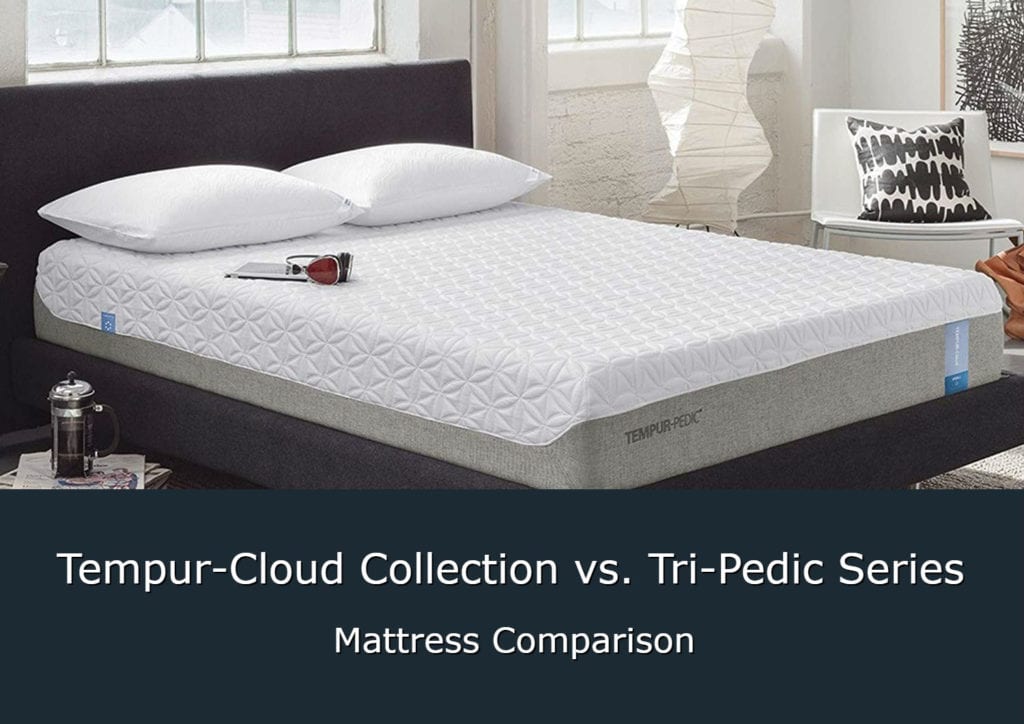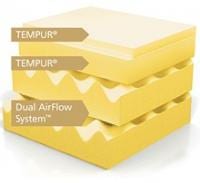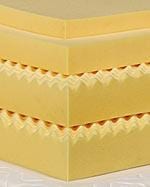
Two Three-Layer Memory Foam Mattress Collections
A memory foam mattress comparison, from the Tempur-Pedic original to TEMPUR-Cloud.
Tempur-Pedic: The Original Memory Foam Mattress
TEMPUR-Pedic introduced visco-elastic foam to the world in the Swedish Tempur Bed featuring the new “Tempur Material.” The term “Tempur” is derived from “temper foam” – what the lead engineer developing the original NASA foam called it, because of its temperature sensitivity. This material also became known as memory foam, because it would “remember” the impression created by a sleeper’s body heat.
This “memory” made the new mattress popular. It conformed to a user’s body shape. The even support reduced pressure on larger parts of the body, such as hips and shoulders. For back sleepers, the hips sink in while the lumbar is still supported.
The Tempur material used in the top layer of the original TEMPUR-Pedic mattress was very dense, 5-7 lbs per cubic inch (lb/in³). The reason was that the higher the density of Tempur material, the more heat-sensitive it is, therefore the more conforming.
Benefits with Problems
It was this conformity and pressure relief that attracted Dr. Rick Swartzburg, a chiropractor in Southern California. He began sleeping on a TEMPUR-Pedic mattress. However, there were two problems related to the high-density foam. First, although it was very heat sensitive, it was hardly pressure-sensitive. This meant (1) it did not respond to a sleeper’s body until it warmed up enough, which was longer when the room was cooler, and (2) it did not change quickly enough if the sleeper moved or changed position. Furthermore, since it absorbed so much heat it became hot enough to be uncomfortable for many sleepers.
Solution
Dr. Rick Swartzburg sought a solution to these problems. He found that lighter 4-lb memory foam was less heat sensitive and more pressure sensitive. But this made it less conforming. Instead of one comfort layer at the top, in 2006 he designed a mattress with two: 4 lb/in³ in the top layer, 5 lb/in³ in the second. This way, it had a faster initial response, was cooler, and still had the deep conformity of the denser memory foam. Like the TEMPUR-Pedic, it also had a high-resilience base layer (support core). Since it had three layers instead of two, he named it the Tri-Pedic, and began making through Relief-Mart, the family business, and selling it under a new brand, Selectabed.
The Response
TEMPUR-Pedic had been receiving complaints about the slow response of their TEMPUR Material and the heat. They had already addressed the slow response with first the 10” high DeluxeBed, then the 13.5” CelebrityBed. As for the heat, the base layer was divided into two layers of convoluted foam to let air move horizontally at the bottom.
DeluxeBed had two layers of Tempur Material. The top layer was about 1¼” of a softer version of 5.3 lb/in³ Tempur Material. The second layer was the standard firmness of the 5.3-lb foam.


DeluxeBed (L) and CelebrityBed (R) cutaway views
CelebrityBed went higher, having a pillow top with the softest version of 5.3-lb Tempur material in addition to the comfort layer. These changes helped with the initial response, but there was still a heat problem.


After Dr. Rick Swartzburg came out with his innovation, Tempur-Pedic responded by producing their own mattress with two densities of visco-elastic foam, the TEMPUR-Pedic Cloud (TEMPUR-Cloud). Since then, the Tri-Pedic has expanded into a 3-model series and the TEMPUR-Cloud into a collection. It is natural, then, to compare Tri-Pedic models with TEMPUR-Cloud models.
Tri-Pedic Series: The Comparisons
Since there have been up to six models in the TEMPUR-Cloud Collection, we pick the three which most closely mirror the Tri-Pedic Series mattress models. We’ll begin with the comparisons given on the Selectabed website.
The Lineup
The three Tri-Pedic Series models are Tri-Pedic Gold, Tri-Pedic Platinum (the original model), and Tri-Pedic Diamond. The TEMPUR-Pedic models they are compared to on Selectabed.com are:
• Tri-Pedic Gold vs. Tempur-Cloud™
• Tri-Pedic Platinum vs. Tempur-Cloud™ Supreme
• Tri-Pedic Diamond vs. Tempur-Cloud™ Luxe
The comparisons on Selectabed’s website for the Tri-Pedic Series models do not have feature-for-feature breakdowns, but simply compare prices for each size and show the similarities or differences on several points.
Size/Price
The sizes used in the comparison charts are Twin, Twin XL, Full, Full XL, Queen, King, and California King. The differences in price between a Tri-Pedic mattress and its TEMPUR-Pedic equivalent ranges from $100 between Gold and T-Cloud for Twin to $1900 between Diamond and T-Luxe for King and California King, with the TEMPUR-Pedic model always more highly priced.
The size/price comparisons reveal one key difference for some shoppers. The Tempur-Cloud and the Cloud Supreme are not available in Full XL, and the Cloud-Luxe is not available in Twin, Twin XL, and Full XL, while all three Tri-Pedic mattresses are available in all the listed sizes.
Featured Points
The featured points of comparison are NASA Memory Foam (developed from the visco-elastic material made for NASA), length of warranty, length of sleep trial, top two layers of 4-lb. and 5-lb. density memory foam, soft feel, made in the U.S.A., patented airflow circulation through both sides and surface (more specifically the Airflow Transfer System), foam certified by Certi-PUR-US™ as environmentally friendly, and being extra supportive.
Comparison Charts on Selectabed.com
| Tempur-Cloud™ | Tri-Pedic® Gold | Tempur-Cloud™ Supreme | Tri-Pedic Platinum | Tempur-Pedic™ Cloud Luxe | Tri-Pedic® Diamond | ||||
| Twin | $1,199 | $1,099 | $2,249 | $1,399 | Not Available | $1,599 | |||
| Twin XL | $1,299 | $1,249 | $2,349 | $1,499 | $3,049 | $1,699 | |||
| Full | $1,399 | $1,299 | $2,549 | $1,599 | Not Available | $1,849 | |||
| Full XL | Not Available | $1,349 | Not Available | $1,649 | Not Available | $1,899 | |||
| Queen | $1,699 | $1,399 | $2,699 | $1,699 | $3,699 | $1,999 | |||
| King | $2,299 | $1,599 | $3,299 | $1,999 | $4,299 | $2,399 | |||
| California King | $2,299 | $1,599 | $3,299 | $1,999 | $4,299 | $2,399 | |||
| NASA Memory Foam | YES | YES | YES | YES | YES | YES | |||
| Warranty | 20 Years | 30 Years | 20 Years | 30 Years | 20 Years | 30 Years | |||
| Sleep Trial | 90 Days | 120 Days | 90 Day | 120 Day | 90 Days | 120 Days | |||
| 4 to 5 inches of combined 4lb. and 5lb. Density Memory Foam | YES | YES | YES | YES | YES | YES | |||
| Soft Feel | YES | YES | YES | YES | YES | YES | |||
| Made In the U.S.A | YES | YES | YES | YES | YES | YES | |||
| Patented Airflow Circulation Through Both Sides and Surface | NO | Optional | NO | Optional | NO | Optional | |||
| Certi-PUR™ Certified Environmentally Friendly Foam | NO | Y | NO | Y | NO | Y | |||
| Extra Supportive | YES | YES | YES | YES | YES | YES | |||
How The Mattresses Are The Same
Where these pairs of mattresses are the same and where they differ include features not appearing on this chart.
• 4 to 5 inches of NASA foam – both brands use four-to-five inches of visco-elastic foam (Tempur material or memory foam) derived from the original foam developed in the 1960s for use by NASA. In both lines, the top layer is a 4-lb density, and the second layer is 5 or 5.3 lb/in³, making the top layer more pressure sensitive (quicker response), and the lower layer more heat sensitive (more conforming).
• Soft feel – As a result of the less dense top layer, both lines have a soft feel.
• Made in U.S.A. – Both companies design and manufacture their mattresses in the United States using foams made here.
• Extra Supportive – Both sets of mattresses are extra supportive, even though soft on top.
How The Mattresses Are Different
• Price – Across the board, model-for-model and size-for-size, the TEMPUR-Pedic mattresses cost more than their Tri-Pedic counterparts.
• Warranty and Sleep Trial – Selectabed covers its Tri-Pedic mattresses with a 30-year warranty and a 120-day sleep trial. At the time the comparison charts were made, the standard Tempur-Pedic warranty was for 20 years. Since then, this has been changed to 10 years; beds sold before the effective date are still covered by the 20-year warranty. The older company’s sleep trial was, and still is, for 90 days.
• Size availability – The selected Tempur-Cloud models are not available in all the sizes in which the Tri-Pedic Series models are, particularly Full XL for all three, plus Twin and Twin XL for the TEMPUR-Cloud Luxe. Not mentions in the charts, since Selectabed makes these to order, they can also make RV and custom sizes.
• Airflow provision for cooling – Each line does have some provision for enhancing airflow for cooling the mattress. However, there are key differences between the two approaches.
The Airflow Transfer System used in the Tempur-Pedic Cloud (and the later version, Tempur-Cloud Select) originally relied on open-cell foams on top and convoluted foam in the two-layer support core. This was limited by the amount of air which could flow through the open-cell foam. Also, convoluted foam may allow horizontal air flow, but this structure tends to erode durability, since the points of the convolution have the potential of deformation or breakage, which may result in loss of support where this happens. Having two convoluted layers doubles this liability without enough of a gain in airflow.
To their credit, the company recognized these problems and modified their Airflow Transfer System. Current “Breeze” models by Tempur-Pedic use ventilated top foams, and the base layers are no longer convoluted, tough how they enhance airflow is not evident in diagrams or descriptions.
On the other hand, Selectabed’s patented Airflow Transfer System, which is optional for the Tri-Pedic mattresses, but standard for its TempFlow and Snuggle-Pedic brands, begins with a special cover fabric (Kool-Flow) which has micro-vents, continues with vertical ventilation of the top layers, and air channels cut into the surface of the base layer. The effectiveness of this is shown in a demonstration video and an animation of the Snuggle-Pedic Mattress.
CertiPUR Certification – We have no reason to doubt the quality of foam used by Tempur-Pedic. While Selectabed’s foams are certified by CertiPUR-US, exceeding its standards by a wide margin, Tempur-Pedic has not sought this certification. Complaints about its foams outgassing are no greater than for many foams which are certified. One apparent reason for not certifying is Tempur-Pedic’s insistence on not calling their TEMPUR Material “memory foam.”
Evaluation
Both the three models in the Tri-Pedic Series and the equivalent TEMPUR-Cloud models are quality mattresses made with quality materials. They all offer support and pressure-relieving conformity with a soft sleeping surface. Tempur-Pedic’s Tempur-Cloud mattresses have the advantage of wider retail distribution in stores and through online retailers, such as Amazon and US-Mattress, while the Tri-Pedic Series is available only on the Selectabed website and in the Selectabed/Air-Pedic/TempFlow showroom in California.
The Tri-Pedic Series models take the advantage on airflow cooling, price, and length of warranty and sleep trial.
Footnote
As covered in the 2018 Update on our manufacturer’s review of TEMPUR-Pedic, the TEMPUR-Cloud Supreme is being replaced by the new TEMPUR-ProAdapt Soft. The original Tempur-Cloud mattress and its successor, TEMPUR-Cloud Select, have already been discontinued. The TEMPUR-Cloud Prima is being replaced by the TEMPUR-Adapt Medium, and the TEMPUR-Cloud Luxe by the TEMPUR-LuxeAdapt Soft.

